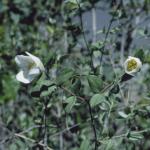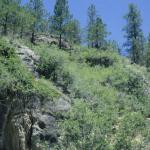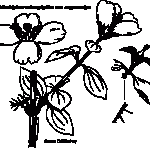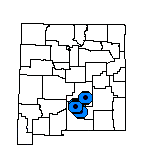Philadelphus argyrocalyx (Silvercup Philadelphus)
PHILADELPHUS ARGYROCALYX WOOTON; PHILADELPHUS SERPYLLIFOLIUS VAR. ARGYROCALYX (WOOTON) M.E. JONES; PHILADELPHUS ELLIPTICUS RYDBERG; PHILADELPHUS MICROPHYLLUS SUBSP. ARGYROCALYX (WOOTON) C.L. HITCHCOCK; PHILADELPHUS WOOTONII HU
| USFWS | State of NM | USFS | BLM | Navajo Nation | State Rank | Global Rank | R-E-D Code | NMRPTC Status | Strategy Status |
|---|---|---|---|---|---|---|---|---|---|
| S3 | G4 | 1-1-3 | R | SS |
| Overall Conservation Status | Documented Threats | Actions Needed |
|---|---|---|
| UNDER CONSERVED | No Information |
Study effects of forest fire |
Erect shrub 1-2 m tall; leaves opposite, ovate, ovate-lanceolate or narrowly elliptic, margins entire, 10-35 mm long, 4-17 mm wide, glabrous or glabrescent above, sparsely villous hairy below, petiole about 2 mm long; flowers usually solitary (rarely 2 or 3) at the end of a short shoot 2-4 cm long with 2-4 pairs of leaves; calyx tube forming a cup (hypanthium); pedicels, hypanthia and sepals covered in dense tomentum of short, woolly hairs and longer, straight hairs; sepals 4; petals 4, white, 1.2-2.2 cm long, 0.7-1.8 cm wide; corolla cruciform, 2.2-4.2 cm across; stamens about 55, filaments fused into bundles; style and hypanthium disk glabrous; each seed long-tailed. Flowers June to August.
The hypanthium and sepals of Philadelphus microphyllus var. microphyllus are glabrous or only sparsely hairy at the base.
New Mexico, southern Lincoln and northern Otero counties, Capitan, Sacramento, and White mountains.
Mountain slopes of usually sedimentary rock in piñon-juniper woodland and lower montane coniferous forest; 2,100-2,600 m (6,900-8,500 ft).
Endemic to the mountains of south-central New Mexico, but relatively common within this limited range. It is a handsome shrub with potential for ornamental use.
This plant is not significantly threatened by the land uses within its habitats. Its response to forest fire has not been studied.
Hu, S. 1954. A monograph of the genus Philadelphus. Journal of the Arnold Arboretum 37:15-90.
Frazier, C.K. 1999. A taxonomic study of Philadelphus (Hydrangeaceae) as it occurs in New Mexico. The New Mexico Botanist 13:1-6.
Henrickson, J. 2007. New combinations in Philadelphus (Philadelphaceae). Journal of the Botanical Research Institute of Texas 1(2):901.
For distribution maps and more information, visit Natural Heritage New Mexico





